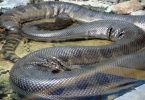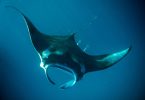In this article, we will be sharing with you some ways through which the largest mammal whales die. We will also share a few necessary details about the whale. It is common knowledge that the whale is the largest mammal in the history of creation. Whales are so large that they are considered very strong and of course expensive.
It is important to know that Whales are also known as cetaceans and some of them are also called blue whales, probably because their sea blue colour.
Of course, everything perishes, and one characteristic of living things among other features is that living things die. Annoyingly, when whale dies and the Cetacean is washed ashore, getting to know the remote cause or even the proximate cause of the death of the whale or Cetacean is usually very difficult, and could be like trying to pass a camel through a needle.
However, thorough study shows that there are so many reasons currently known to be the cause of the death of the Cetacean. These reasons are either natural or anthropogenic (which implies direct or indirect).
How do whales die?
The question of how whales really die is puzzling but we will be sharing the many ways to die (for whales) in this section.
The mammal whale dies through various ways, some of which include:
- Cetacean stranding or beaching
- Natural causes of the death of whales
- Anthropogenic causes
1. Cetacean Stranding or Beaching
This method of dying by whales can be likened to suicide if the tables were to be turned and a human being dies by beaching or cetacean stranding.
Cetacean stranding, which is also known as beaching, is the phenomenon or the process by which whales or even dolphins drop themselves on a beach (that’s why it is called beaching), or on land. So, this occurs when a whale swims to the land surface or sea shore and dies off as a result of dehydration. Sometimes, in the process of beaching, the whale collapses under its own weight, or drowns when the blowhole is covered or masked by the high tide.
There have been a series of deaths of whales accounted to be caused by beaching. The big question is why do cetaceans its whales strand themselves.
Amazingly, there have been so many explanations as to the reason cetaceans or whales strand themselves on lands or on beaches.
Some of these reasons include the following:
- Unpredictable changes that occur in the temperature of water.
- Unique echolocation of whales in certain areas or surroundings, as well as some geomagnetic disturbances.
- Unfortunately, none of these reasons have been generally accepted as the reason why whales will decide to strand themselves in the universe.
More so, it is said that a link has been found between the use of mid-frequency active sonar, and mass beaching of beaked cetaceans or beaked whales, which could be responsible for that behavior.
Other reasons include:
The natural deaths of whales at sea
When whales die, the carcasses of the deceased cetaceans or whales usually float on the surface of the sea after a while. When this happens, winds or currents or sea waves could really carry the carcasses of the dead whales to a coastline.
Now, because an average or rather thousands of whales or cetaceans die in the sea every year, so many of the dead whales become stranded after their death.
Also, most of the carcasses of the whale do not get to the coast, and so are usually scavenged, or even decompose enough for it to sink to the bottom of the ocean, and so the carcass of the dead whale begins to form the basis of a different local ecosystem that is also called a cetacean fall or whale fall. Sometimes when living whales see that so many of their kinds die in the sea, they begin to strand.
Individual strandings
More so, the live strandings of whales or the Cetacean strandings often happen as a result of individual injuries or even individual ailments. So because they are in the wild and are not domesticated, they lack adequate medication or even human attention which can also lead to the individual stranding of the mammal called whale.
Multiple strandings
While there are cases of individual strandings, there are also cases of multiple strandings, which are quite rare, and could also attract media coverage and as well as attract some rescue efforts in the process.
More so, the firm social cohesion of toothed whale or cetacean pods often appears to be a major factor in the very many cases of multiple stranding. For instance, if one whale gets into trouble in the sea, it could make a distress call that may prompt the rest of the cetacean pod to follow through and even beach or strand themselves eventually alongside.
It is also important to know that multiple deaths offshore are very unlikely to really lead to multiple cetacean strandings or beaching, since winds, currents, or sea waves are usually variable, and could scatter a group of whale corpses.
2. Natural Causes of death of whales
We are established in the introductory section that Cetaceans like humans and every other living things are prone to death, because death is one characteristics of living things.
Suffice it to say that one of the most natural causes of the death of a whale is simply from old age. This simply mean that whales can die from old age. That being said, it is important to know that the lifespan of whale or cetacean ranges from a few decades to over two hundred years especially in the case of the bowhead whales.
-
Attack from predators
Apart from dying as a result of old age, whales or cetacean can also die as a result of attacks from predators. Some of these predators include the killer whales, the polar bears and even the sharks.
Of course, you may wonder how it is possible for whale that happens to be the largest mammal to actually be attacked by predators. It is vital to note that the case of attack from predators is prevalent mostly with the smaller sizes and species of whales, as well as the calves of bigger cetacean, which are mostly targets for the water mammal predators.
-
Stray whales
Just like humans sometimes stray or get lost, newly weaned whales or inexperienced cetacean can easily lose their way and become stranded.
Also, cetacean could even die from parasites, diseases, and even as a result of difficulties during birth of young ones, just like in human beings. Although these are natural events, they can often be increased by some threats that could be posed by human beings.
3. Anthropogenic causes
This simply refers to the causes of death of whales that are caused by humans, or human activities. This is usually directly or indirectly.
So, in this section, we will be sharing some of these anthropogenic causes that can possibly account for the death of whales or rather can fix the puzzle of how whales die.
-
Ingestion of plastics
In the hierarchy of deaths of whales by man-made causes, one of the most anthropogenic or human caused threats that animals face around the world, ingestion of plastics.
This is because plastics are used by humans and are wrongly dumped just like most refuses are wrongly dumped. So when there is an ingestion of plastics by whales, the plastics make the whales feel very full almost all the time, that it prevents them from having to eat nutritious meals, so they get malnourished.
Also, the ingestion of plastics can actually perforate the stomach, or the intestine of the cetacean. This however leads to a very slow death that happens as a result of starvation because the whale is malnourished and also unable to feed at the same time.
-
Vessels strikes
In the Northern part of Atlantic, right whales that inhabit both in Canadian and in American waters are one of the most endangered whales as the major cause of the death of whales in the area are vessel strikes.
However, this happens with common signs, or symptoms as you may call it. So, some of the symptoms or common signs of vessel strikes in whales or cetaceans are propeller injuries as well as blunt force trauma.
Vessel strikes happen during the collision of ships with either ships, icebergs, or something else. Hence, the whale is almost in a helpless state, and so the ability to avoid collision of ships, is largely depending on the whale’s ability to detect the ships and avoid them, as well as the acceleration rate of the ship.
-
Aquarium Trade
Aquarium trade or the trade of aquariums simply refers to the trade of aquatic animals or water animals.
So, while the whale is in the wild, there are negotiations and bargains around the wild cetaceans. However, the trade of wild whales is not a new line of business or trade, the trade of whales is a trade that has been going on between aquarists for a long period of time, best put, it has been going on for decades.
Albeit, apart from the risk connected to getting caught in the wild, and the risk of transportation, aquarists have been able to prove in their studies, that whales which have been captured from the wild, or that cetaceans which are captives have have the tendencies of losing the good state of their health as a result of the mental suffering or torture and physical suffering that come with being captured from their home; the wild.
You may wonder why it is so, that cetaceans which are captives or which are captured from the wild begin to lose their good health from physical suffering, as well as mental torture and suffering. Now here is why it so.
When cetaceans are captured, their health begins to detoriate because they are taking our of the wild and put in artificial surroundings. This should not come off as surprising to anyone because this situation is common among humans too.
Secondly, the capturing of cetaceans, especially those that have spent decades in the wild are more prone to suffer from situation of inadequate living, because when they are not in the wild that they are used to, they consider other environments not suitable for them.
Thirdly, the captivated cetaceans from the moment they are captured from the wild feel isolated, and being isolated from the wild, they have limited or even no social interactions with the wild and the other species of whales or aquatic animals in the wild, they feel alone which humans can experience sometimes. More so, in addition to the feeling of being alone, because they are not in the wild, they have some restrictions in their behaviour.
This could be likened to when a person is forcefully made to leave their home or their comfort zone, it sure leaves some restrictions in the person’s behaviour.
Furthermore, when animals or mammals that are highly social like cetaceans are isolated from their environment, as well as their social units of close-knit, the mental health of the whale becomes endangered and tortured.
All of these situations listed are above can account for the death of different species of whales during the aquarium trade. So chances are that seven in ten captivated cetaceans do not survive outside the wild.
-
Starvation
In one the preceding sections, we established that when whales ignorantly feed on plastics that they feel full all the time till they are malnourished and they eventually die slowly and daily till they are finally dead.
Apart from starvation that comes from the ingestion of plastics, when whales are taking out the environment, they safe very familiar with, they are deprived of the activity of hunting in the wild, so they have no chances of feeding on preys. Sometimes, this new development leads them into the state of starving.
Just like humans and mammals, whales store up fats in their bodies, so while they start, the body uses up the reserves of fat stored in the body, which however increases the risk in whale’s matters because there are very high tendencies that the fat reserves or lipid loving house get contaminated by chemicals.
-
Acoustic noise
An acoustic noise is basically pressure that comes from waves of travelling either through air or by other gases and is heard. For instance, sound that is audible is an acoustic energy in the area it could be heard. This simply means that the acoustic energy or the acoustic noise can be heard.
However, when there is noise in the sea as a result of sea transport using ships, ferries, and other sea travelling agents, and waves. These noise or acoustic sounds have certain impacts on the different species of cetaceans, because for the whales, their most active organ of perception is the sense of hearing.
Sadly, in recent times, oceans have become very noisy, which affects the mammals, that is the whales, and eventually leads to the difficulties different species of whales can experience while trying to navigate in the wild or communicate with their habitats and inhabitants, as well as makes it difficult for them to get their preys because they move more towards the direction of sound.
Even aquarists have in their studies shown that there is a firm relationship or connection between acoustic noise like bursts, which includes military naval sonars, seismic exploration, and the death of whales through the cases of mass stranding or beaching. Acoustic noise makes whales lose their balance in the eco system.
-
Contaminations by chemicals
Pollution is an activity of man that really destroys the universe. Chemicals like polychlorinated biphenyls or PCBs, polybrominated diphenyl ethers or PBDEs and so many more often pollute seas and marine surroundings or environments in general.
This negative development has been proven by study to have really concentrated in the blubber layers of a lot of whales or different species of cetaceans.
Aquarists have also shown that this is as a result of biomagnification. However, biomagnification is a phenomenon in which poisons or toxins as well as other substances rapidly accumulate in different levels of the food chain in the ecosystem which puts different species of cetaceans or whales at risk.
-
Change in climate
Humans and living things in general are usually affected by the changes that occur in climates. However, these changes also affect the different species of whales. Take for an instance that there is a reduced sea-ice cover and tremendous increase in temperatures, preys in the wild begin to seek refuge and hide, which will gradually result in reduction of the availability of preys for the whales.
More so, a change in climate can result in migration which is very common among animals, so both the preys and predators, different species of whales included have the tendencies of migrating.
Again, if there are situations where sea-ice cover is depleting, this often creates a path and makes more ways for tons upon tons of vessels in areas where it was usually difficult for vessels to navigate. Maybe some surroundings of the Arctic; which equally adds to the probability of more species of cetaceans getting involved in collisions. During the ice break, the temperature of the sea is also affected, and this increase in the temperature of the sea actually affects so many aquatic species that require specific temperature in the aquatic habitat.
Conclusion
Humans have many ways to die, so those the whales and we have shown you that in this study.







